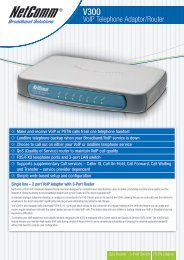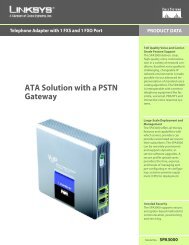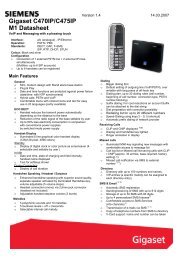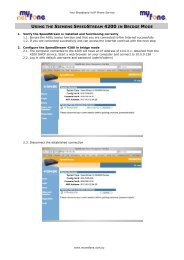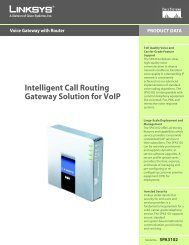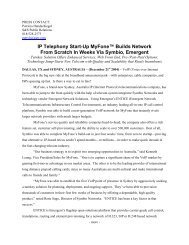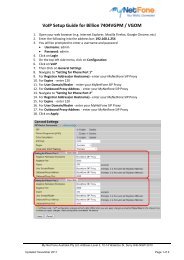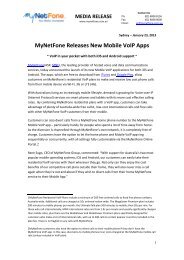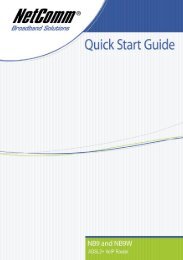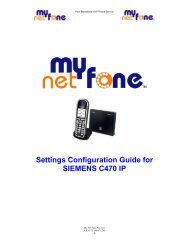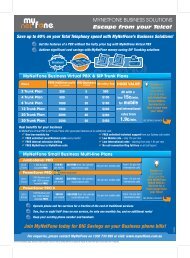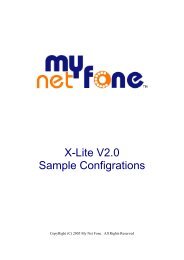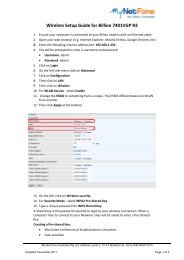Create successful ePaper yourself
Turn your PDF publications into a flip-book with our unique Google optimized e-Paper software.
dialed-number is not specified or is the same as , the SPA interprets this as a request for 2-stage dialing (see next section). Otherwise, the SPA processes the dialed-number by acorresponding dial plan. If the dial plan processing fails, the SPA replies with a 403 response.Otherwise, it replies with a 200 response and at the same time takes the FXO port off hook and dialsthe final number returned from the dial plan to the PSTN switch.4.5.2. Two-Stage DialingIn 2-stage dialing, the VoIP caller will need to dial the target PSTN number upon successfulauthentication. If the dial plan configured for this VoIP caller is “none”, SPA will take the FXO port offhookbut will not dial any digits automatically after accepting the caller for gateway service. Hence thecaller will hear the dial tone directly provided by the PSTN switch, which will interpret the targetnumber dialed by the VoIP caller. If the dial plan is not “none”, the SPA will play the Outside DialTone to direct the VoIP caller to dial the PSTN number; the FXO port will stay on-hook while the SPAcollects a complete PSTN target number from the caller according to the selected dial plan. If thedialed number is valid, the SPA takes the FXO port off-hook and dials the final target numberreturned from the dial plan to the PSTN switch accordingly. If the dialed number is invalid, the SPAterminates the call immediately.To invoke 2-stage dialing, the VoIP caller can form a SIP INVITE request to send the PSTN Linewithout a user-id field in the Request-URI or with a user-id that matches exactly the of thePSTN Line. Other user-id in the Request-URI will be treated as a request for 1-stage dialing (Section4.5.1) if 1-stage dialing is enabled, or dropped by the SPA (as if no user-id is given) if 1-stage dialingis disabled.The VoIP PIN digits and target number digits must be sent to the SPA out-of-band using theRFC2833 protocol (a.k.a. AVT Tone). The SPA does not accept any DTMF digits sent to it in-bandover VoIP.Notes:- VoIP-To-PSTN Gateway function can be globally disabled by setting to “no”; SPA will reply with a 503 response to inbound INVITE sent to the PSTN Line- If the PSTN line is not connected, or is in use by another extension or another VoIP caller, theSPA will reply with a 503 response to inbound INVITE sent to the PSTN Line- The of the PSTN Line can be blank. In that case Registration should be disabled forthe PSTN Line- When the SPA decides to accept an incoming INVITE, it immediately sends a 180 response tothe VoIP caller, and eventually a 200 response to “answer” the call. You can set the desired delaybefore the SPA sends out the 200 response after the 180 response in the parameter. This delay can be 0.- You can insert a small amount of delay before the SPA starts auto-dialing the final target numberto the PSTN line after the SPA takes the FXO port off-hook. This delay is specified in the parameter. This delay is used to make sure the PSTN switch is ready to receiveDTMF before the SPA starts dialing.Below is the pseudo code for accepting a VoIP caller for PSTN gateway service.If (VoIP Caller-ID Pattern Blank or VoIP Caller-ID Matches a VoIP Caller-ID Pattern) {If (VoIP Caller in VoIP Access-List or Authentication Disabled) {Reply 200Start PSTN Gateway Service}Else {© 2003 - 2004 <strong>Sipura</strong> Technology, Inc Proprietary (See Copyright Notice on Page 2) 47



